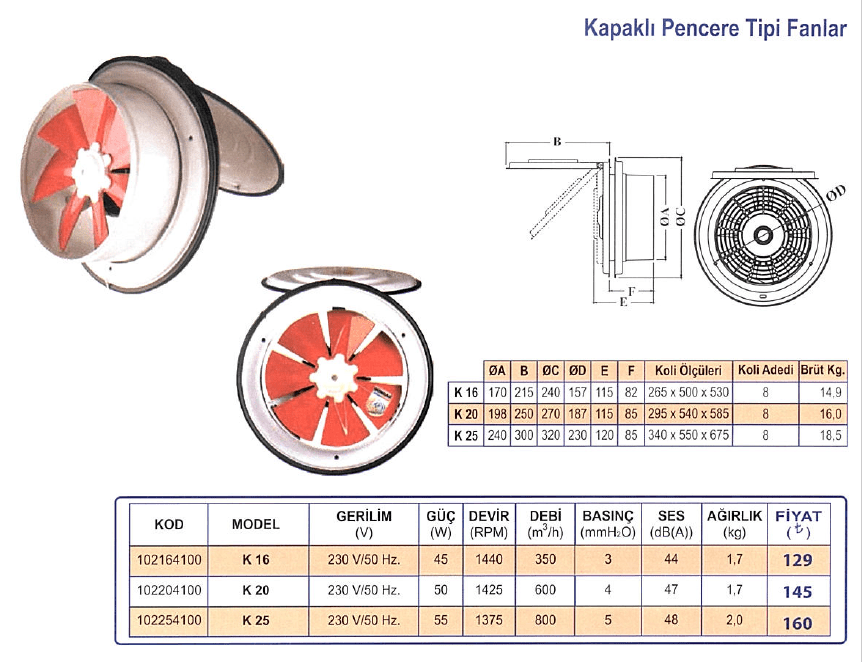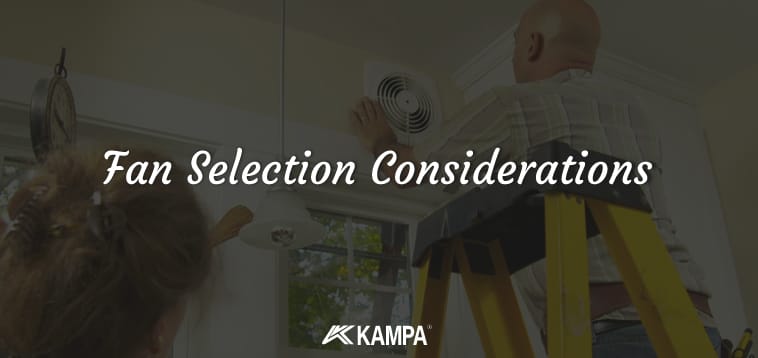Fan Selection Considerations
In this blog post, we will explain the ventilation fan selection in its simplest form. We are with you with the best fan selection considerations methods, click here.
Table of Contents
Among hundreds of products, it can often be difficult to find the right fan depending on your use case and needs. Moreover, the graphics in the fan descriptions are not at all understandable for someone who is not familiar with them.

In our previous blog post, we talked about fans and their uses. To remind you, fans are devices that provide air flow by creating a pressure difference. They work by suction from the motor part and blowing from the fan part. There are two types of fans, axial and radial.
4 Parameters to Consider When Fan Selection
- Required air flow rate
- Pressure losses
- Acceptable sound level
- Electrical power connection type
The air exchange required for the environment to be ventilated is important in fan selection; it is related to the intended use of the environment, the number and activities of the living beings and objects in it. In the next table, the required air exchange coefficients for different environments are given.
| ENVIRONMENT | AIR EXCHANGE COEFFICIENT | ENVIRONMENT | AIR EXCHANGE COEFFICIENT |
|---|---|---|---|
| Auditoriums | 6-8 | Laundries | 10-20 |
| Classrooms | 5-7 | Offices | 4-8 |
| Libraries | 4-5 | Indoor pools | 3-4 |
| Paint ovens | 25-50 | Restaurants | 8-12 |
| Cash safe rooms | 3-6 | Conference rooms | 6-8 |
| Cinema and theaters | 5-8 | Waiting rooms | 4-6 |
| Home kitchens | 15-25 | Photocopy rooms | 10-15 |
| Commercial kitchens | 15-30 | Machine rooms | 10-40 |
| Bathrooms | 5-7 | Shops | 4-8 |
| Household wc’s | 4-5 | Dry cleaning | 5-15 |
| Public wc’s | 8-15 | General malat fields | 4-8 |
| Meeting rooms | 6-8 | Clothes change rooms | 6-8 |
| Foundries | 8-15 | Hospitals | 8-12 |
| Gymnasiums | 4-6 | Laboratories | 8-15 |
Depending on the activity, the amount of air per person in living and working spaces can help to determine the air flow rate needed for fan selection.
| Normal activity (non-smoking) | 29m3 / hour |
| Normal activity (smoking) | 58 m3 / hour |
| Light activity | 45 m3 / hour |
| Heavy activity (industrial work areas) | 60 m3 / hour |
In line with the information given above, the air flow rate required for fan selection is determined as follows.
Q [m3/h ] = Air exchange coefficient (1 hour) * Ambient volume (m3 )
Or
Q [m3 / hour ] = Number of people * air flow rate required per person
After determining the required air flow rate in the environment, appropriate duct design (taking into account sound and air velocity criteria) should be made and pressure losses should be calculated.
Depending on the environment in which the fan will operate, the fan type (axial, radial, roof, smoke evacuation, etc.) should be decided for fan selection and the appropriate fan should be selected on the curve according to the determined flow-static pressure binary.
If we briefly explain what is written above and what is in the table with an example for fan selection;
If 5 people work in an office and the ceiling height is 2.6 meters and the floor area is 50m2, it has a volume of 2.6 * 50 = 130m3. The value given for the office in the air exchange coefficient table was 4-8. Let’s consider the average as 5.
130*5=650m3 /h air requirement. If we assume that the office is working with normal activation, 5 people * 29m3 = 145m3 air requirement for employees in total 650 + 145 = 795m3 / hour air requirement arises.

Fan selectionis also made according to this flow rate requirement.
After calculating the flow rate, the area where the fan will be mounted should be determined. Where will the fan be installed? Ceiling, wall, chimney or ventilation pipe.
Another issue is the voltage of the electricity to be connected to the fan. Since our example is based on an office, let’s proceed with the fan selection from there. Fans are usually mounted on the wall or glass in offices. Since household electricity will be used, a single-phase fan should be preferred.
So I need an axial, single phase, glass or wall mounted fan with a flow rate of 795m3 / hour. Let’s analyze the graphics under the products.
When I evaluate these two images, the first thing I have to decide is whether it is a wall type or a window type. Suppose I choose a wall type fan. The air flow rate I needed was 650 + 145 =795 m3 / hour.
In this context, the most suitable fan for me would be the D 25 model with a flow rate of 800 m3 / hour. Click here for detailed information on ventilation fan cleaning. Click here to buy a wall-mounted cooling fan.

